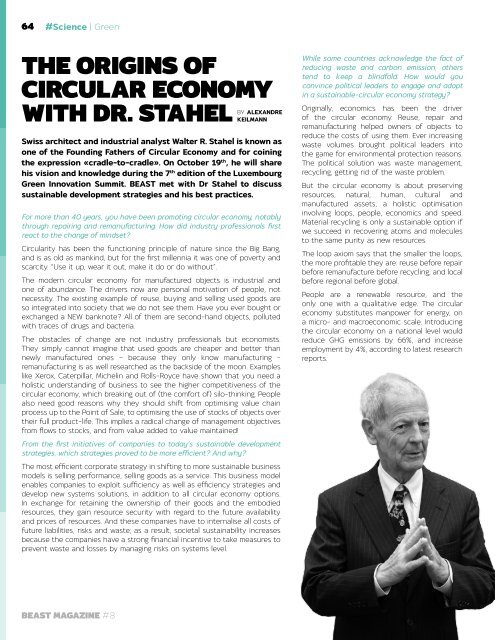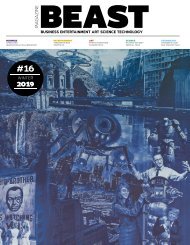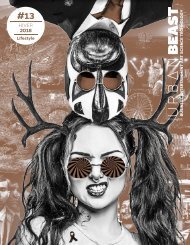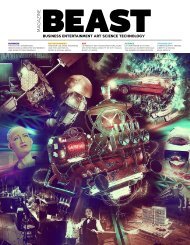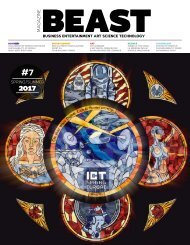Magazine_BEAST_2017_Edition_8_complet
You also want an ePaper? Increase the reach of your titles
YUMPU automatically turns print PDFs into web optimized ePapers that Google loves.
64<br />
#Science | Green<br />
THE ORIGINS OF<br />
CIRCULAR ECONOMY<br />
WITH DR. STAHEL<br />
BY ALEXANDRE<br />
KEILMANN<br />
Swiss architect and industrial analyst Walter R. Stahel is known as<br />
one of the Founding Fathers of Circular Economy and for coining<br />
the expression «cradle-to-cradle». On October 19 th , he will share<br />
his vision and knowledge during the 7 th edition of the Luxembourg<br />
Green Innovation Summit. <strong>BEAST</strong> met with Dr Stahel to discuss<br />
sustainable development strategies and his best practices.<br />
For more than 40 years, you have been promoting circular economy, notably<br />
through repairing and remanufacturing. How did industry professionals first<br />
react to the change of mindset?<br />
Circularity has been the functioning principle of nature since the Big Bang,<br />
and is as old as mankind, but for the first millennia it was one of poverty and<br />
scarcity. “Use it up, wear it out, make it do or do without”.<br />
The modern circular economy for manufactured objects is industrial and<br />
one of abundance. The drivers now are personal motivation of people, not<br />
necessity. The existing example of reuse, buying and selling used goods are<br />
so integrated into society that we do not see them. Have you ever bought or<br />
exchanged a NEW banknote? All of them are second-hand objects, polluted<br />
with traces of drugs and bacteria.<br />
The obstacles of change are not industry professionals but economists.<br />
They simply cannot imagine that used goods are cheaper and better than<br />
newly manufactured ones – because they only know manufacturing -<br />
remanufacturing is as well researched as the backside of the moon. Examples<br />
like Xerox, Caterpillar, Michelin and Rolls-Royce have shown that you need a<br />
holistic understanding of business to see the higher competitiveness of the<br />
circular economy, which breaking out of (the comfort of) silo-thinking. People<br />
also need good reasons why they should shift from optimising value chain<br />
process up to the Point of Sale, to optimising the use of stocks of objects over<br />
their full product-life. This implies a radical change of management objectives<br />
from flows to stocks, and from value added to value maintained!<br />
From the first initiatives of companies to today’s sustainable development<br />
strategies, which strategies proved to be more efficient? And why?<br />
The most efficient corporate strategy in shifting to more sustainable business<br />
models is selling performance, selling goods as a service. This business model<br />
enables companies to exploit sufficiency as well as efficiency strategies and<br />
develop new systems solutions, in addition to all circular economy options.<br />
In exchange for retaining the ownership of their goods and the embodied<br />
resources, they gain resource security with regard to the future availability<br />
and prices of resources. And these companies have to internalise all costs of<br />
future liabilities, risks and waste; as a result, societal sustainability increases<br />
because the companies have a strong financial incentive to take measures to<br />
prevent waste and losses by managing risks on systems level.<br />
While some countries acknowledge the fact of<br />
reducing waste and carbon emission, others<br />
tend to keep a blindfold. How would you<br />
convince political leaders to engage and adapt<br />
in a sustainable-circular economy strategy?<br />
Originally, economics has been the driver<br />
of the circular economy. Reuse, repair and<br />
remanufacturing helped owners of objects to<br />
reduce the costs of using them. Ever increasing<br />
waste volumes brought political leaders into<br />
the game for environmental protection reasons.<br />
The political solution was waste management,<br />
recycling, getting rid of the waste problem.<br />
But the circular economy is about preserving<br />
resources, natural, human, cultural and<br />
manufactured assets, a holistic optimisation<br />
involving loops, people, economics and speed.<br />
Material recycling is only a sustainable option if<br />
we succeed in recovering atoms and molecules<br />
to the same purity as new resources.<br />
The loop axiom says that the smaller the loops,<br />
the more profitable they are: reuse before repair<br />
before remanufacture before recycling; and local<br />
before regional before global.<br />
People are a renewable resource, and the<br />
only one with a qualitative edge. The circular<br />
economy substitutes manpower for energy, on<br />
a micro- and macroeconomic scale. Introducing<br />
the circular economy on a national level would<br />
reduce GHG emissions by 66%, and increase<br />
employment by 4%, according to latest research<br />
reports.<br />
<strong>BEAST</strong> MAGAZINE #8


